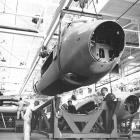16
When the Smithsonian Institution in Washington acquired a WW I Albatros fighter, some of the best vintage aircraft experts in the world were perplexed at how to restore its wooden monocoque fuselage. They intuitively thought that lap joints on the inner skin should coincide with the location of bulkheads, yet this was not the case. Finally some film was located that showed workers at the old Albatros factory carrying an entire half fuselage shell that had no bulkheads. Only then was it was clear that the shell had been formed independently of the bulkheads, and that the function of the bulkheads was just to hold the two fuselage halves together.Wooden monocoque construction had become a lost art. Its merits were never well understood. The potential of the Mosquito was always underestimated, even by its designers. Later versions doubled the original bomb load and range. The Mosquito turned out to be by far the best multi-role aircraft of WW II.
Today, small teams of dedicated aircraft restorers around the world, including the Mosquito Group of the Canadian Historical Aircraft Association of Windsor, Ontario, are relearning the old skills of wooden aircraft construction.

